Archives
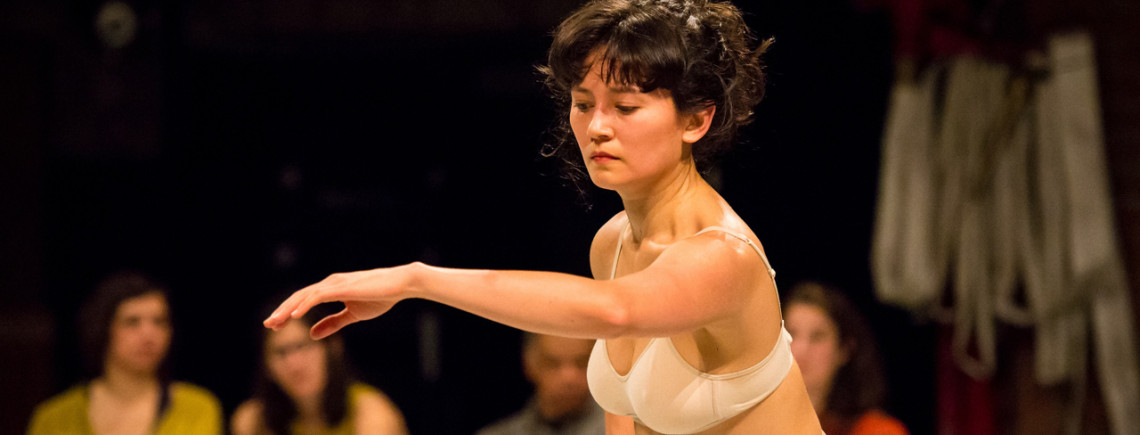
Interior Design
Interior Design
by Samara Davis
Published on: January 14, 2014
Commissioned in 2006, myendlesslove (mel) was Miguel Gutierrez’s personal challenge to make a different kind of solo than Retrospective Exhibitionist (RE) produced a year prior. Whereas the latter dealt with an artist taking stock of his career, mel’s subject turned inward and grappled with the vicissitudes of love, sex, and desire. Gutierrez has written that mel came after a difficult break-up, when he was frustrated with the “lack of space for queer grief in a world of pix and profiles.” To say that mel was a turning inward for Gutierrez, in contrast to RE, might be a complicated observation since RE was explicitly about Gutierrez—his past, his work, and how they bound together in a future projection of self. In a similar way that mel carved out a space for queer grief, I think RE carved out a space for a self as performer. These solos (well, one former solo) seen together, are deeply informing of how an artist negotiates what the world offers him and what he does with it.
I spent a lot of time in 2010–2011 writing on RE, watching the video of the piece and thinking about its themes: identity, the dancer’s body, a past that persists in the present. It’s difficult for me not to compare Michelle Boulé’s WONDER with the styles and circumstances of Gutierrez’s self-explorations, particularly RE; both are seminal solo works that announce/d a new moment in each artist’s career. Of course, these pieces, created almost a decade apart from one another, are different—each emerge from the respective axes of two different lives. Still, the first time I saw WONDER at Issue Project Room in 2013, I was struck by the similarities between them. Not only do Boulé and Gutierrez share a movement vocabulary after years of collaborating and working with one another, but their performances also share an aesthetic that is closely tied to their process.
Pairing these two works is like drawing a picture next to your friend who is drawing the same thing. The differences manifest in the most intimate of details, like the trace of a hand in a scribbled line. How do you measure the effects of collaboration? To whom or what do you attribute influence? Both of these works attest to the impossibility of separating out a life or practice into discrete sources. We are the traces of everyone we’ve ever known, ourselves included.
As dancers, both artists embody movement with an impressive elasticity that is just as much corporeal as it is emotional. Every muscle is used—movement seeming to hold the cells together. Intimacy is a medium, and in inhabiting a role there is a felt at-homeness in space.
I’ve never seen Boulé struggle with a role as a performer, though I don’t mean to say “she makes dancing seem easy” or anything like that. I mean that there’s something more exceptional going on, like an evacuation of the self in order for her body to become most hospitable to the forces of each dance. Of course, this is the consequence of a lot of training and talent but Boulé the person (outside the dance) always seems to tread lightly on Boulé the performer’s territory. WONDER addresses this division—how striving towards perfection as a dancer also means perfecting someone else’s vision of yourself, which dictates what your body can and should do. Though WONDER announces a kind of choreographic debut for Boulé, it seems that in Boulé’s previous work, and especially with Gutierrez, the roles of choreographer and dancer have been messy—more an alchemy of influence than direction via dictation. But Boulé is indeed carving out space for herself in this piece. Both RE and WONDER, and to some extent mel, are expository trips. The self-exposure each artist performs is also an investigation, coming at a moment of mastery (or restlessness) when one can no longer hide behind or be satisfied with technique alone.
In committing to self-exposure, you know fully well that if transformation is what you’re after, everything’s game to be used. This is part of Boulé and Gutierrez’s economical aesthetic, an abundance in laying-bare. Each dancer makes a space through movement (like the aftermath of a party, we survey the scene and know something happened here). It’s a staging that’s both minimal and excessive. Bare set-ups where the few materials invited work hard for them—doubling and tripling as costumes, scenery, and props all at once. Music and sound also make the space in these productions. Music is crucial—pop that carries a mood, but also electronic/ambient compositions that duet with movement. Knowing how to orchestrate silence and breath is key too. The voice is used to both create an identity and distort it, a practice common to all of Gutierrez’s works. In WONDER, Boulé’s voice is used for a pre-recorded narrator-self, a sing-a-long queen, and frenzied screamer, with two subtle and strange bird-like calls at the performance’s end.
During one of these moments, Boulé shouts “yes” over and over again in response to questions from an acousmatic voice hovering over the space and taunting Boulé into convulsive fits. [Is there enough time? Yes! Are you enough? Yes! Are we running out of time? Yes! Do you want more gun control? Yes! Do you want children? Yes! Do you want less gun control? Yes!] These full body cries remind me of a moment in RE when Gutierrez repeatedly screams “Luck” in response to a future that cannot be completely controlled, one that is determined by the competing forces of empowerment, and luck. Boulé’s “Yes” is full of a similar anguish—an affirmation engorged with complications (a “yesterday’s solutions are tomorrow’s problems” approach). But Boulé’s shouts are also hilarious. Her straining, her pushing to affirm, is not without pleasure—for her and for us.
The body or subject that’s produced in these works also breaks down in movement that’s strange and alien. The question of what a body can do becomes what is a body, at least a fully knowable one in the space of a performance (a question I certainly struggle with here, maneuvering along the murky lines of performer/person and performance/performativity). The last section of WONDER involves Boulé moving inside the circle’s perimeter engaging with each member of the audience through a nonverbal language of vaguely familiar and uncanny gesticulations. Her feet and hands are light and fluid. The tap tap tapping of Boulé’s toes and fingertips remain alert, finding their way like antenna sniffing out and marking the floor.
In one of my favorite parts of WONDER, Boulé is in full-on battle mode. Sliding across the floor on her back, her aqua ‘80s pageant gown is hiked up above her torso with her head drowning in a messy expanse of crinoline and satin. Boulé inches forward, first with her feet, and then with frog-like legs bringing the rest of her with them in a kind of horizontal hop as Evelyn Champagne’s song “Love Come Down” comes to a close. Pulling her full-bodied hosiery up around her shoulders she stuffs the front excess material of her gown inside it. Moving to her feet, now haloed by the white and aqua fabric that trails her like obscene plumage, Boulé marches around the space, whipping and waving her arms, extending her legs in the air, and wrangling with that monster dress. Her grace is still there in extension but it’s punctuated by brutal fits and stops.
It is after this battle scene that Boulé takes a seat in the only empty chair of the circle. Cooling off and catching her breath, and intimately flanked by audience members, she becomes part of us for a moment. I thought of the arrangement in Gutierrez’s And lose the name of action (2012) when all the performers took seats in a round. I would like to think of Boulé’s poignant respite as an elegant citation, reworked for a singular moment when she surveys the scene she created.
image: Ian Douglas
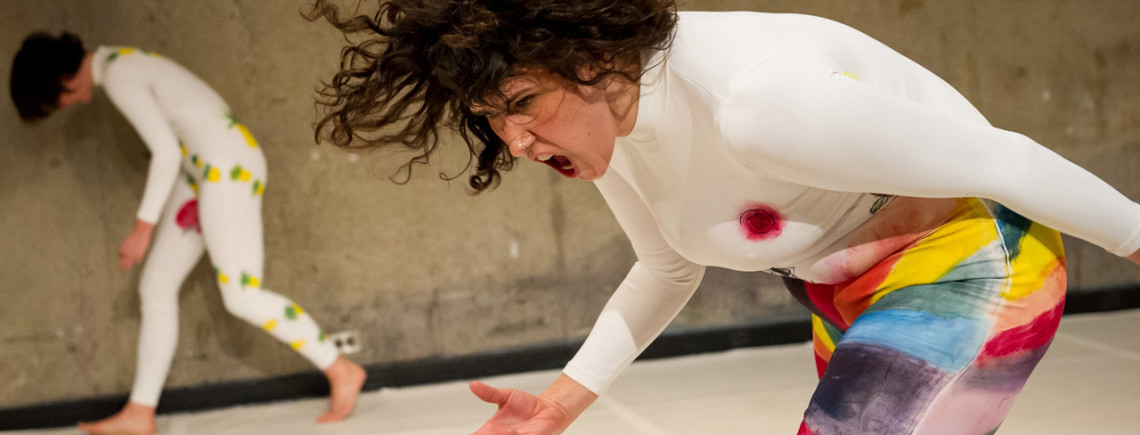
300 Words on Realness: Out of and Into (8/8): STUFF
300 Words on Realness: Out of and Into (8/8): STUFF
by Lydia Mokdessi
Published on: January 14, 2014
Out of and Into (8/8): STUFF opens with Moriah Evans and Sarah Beth Percival pacing in opposite pathways around the perimeter of a white square, narrowly missing collisions with each other on the diagonals. Heads sink to sternums and they gradually droop forward while marching, fingernails eventually grazing the floor. Soon they are on all fours. One coughs and they snap their heads to stare at each other, smiling. They burst into action, slamming / sweeping / swinging their body parts across the floor and meeting up nose-to-nose, pumping their navels towards the floor with yelps of “1-2-3-4 pine-ap-ple pine-ap-ple head-butt-ribs!”
They leap to their feet and scream at top volume, now sprinting their angular route. Their cries range from piercing screeches to guttural growling with one solitary “ayayayay!” war cry. This episode is startling then overwhelming then funny then annoying and then we are kind of jealous; it feels incongruous to sit and watch politely while Evans and Percival abandon decorum for primal release.
They collapse pathetically to the ground and catch their breath before returning to locomotion with a strain-y, effortful floor pattern. They work at the edge of flexibility, distorting into alien shapes while inching aimlessly along. It’s not always clear which body parts are bearing weight as torsos are twisted and limbs held aloft. It is always extreme and sometimes veers towards anguished — unlike circus contortionists, their faces show discomfort. We gasp when the landing of one’s butt narrowly misses the other’s head and when necks are forced into precarious postures.
The movement language feels purposeful; it’s not smoke and mirrors, we believe that they are working to capacity. But the most memorable aspect for me is the question of their relationship: they are twinned in some way, but doppelgängers? Adversaries? Partners? Two halves of one? Maybe, like a real-life intimate relationship, they are all of the above.
image: Ian Douglas
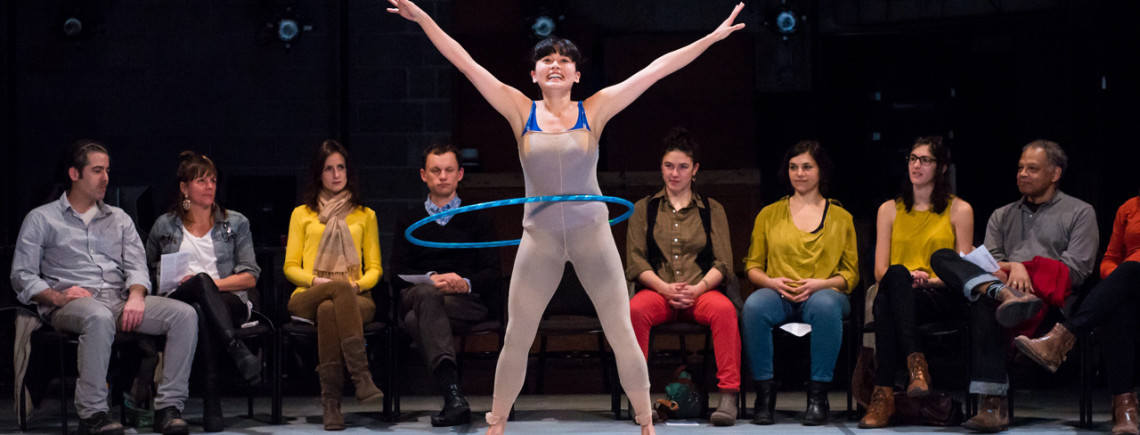
300 Words on Realness: WONDER
image: Ian Douglas
300 Words on Realness: WONDER
by Lydia Mokdessi
Published on: January 14, 2014
In WONDER, Boulé strides out in the nude, arms outstretched behind her with rigid hands, a facsimile of open-mouthed joy plastered to her face. She step-touches animatedly in front of and behind us and soars off, head tilting as she arcs like a bird. Having retrieved her blue jersey separates, she changes gears and begins an expansive dance, accompanied by an autobiographical recording detailing her trajectory as a young dancer and high-achieving student. She references her “genetically-instilled work ethic” and “pavlov response to good.”
Her voice is replaced by a male one, who asks a rapid fire series of questions (would you like more potato chips? more love? more gun control?) to which she yells her reply (it’s always YEAH!). She puts on a mermaid-ish gown, blue wig, and googly-eye glasses and sings uninhibitedly to Evelyn Champagne King’s “Love Come Down” before throwing herself onto her back and inching along heels first, her dress riding up to her chest and later being stuffed into her tights. She revolves a hula hoop around her waist through a series of airborne tricks, earning woops of support. We’ve become her cheer squad. We’re forgiving when she drops the hoop. We wonder if there’s an undertone of manipulation in the taped affirmations (great job! wow! what I like about you is…) and who she is trying to please.
Back to tights and bra, she begins a series of metamorphosing standing and kneeling postures, some that reach stillness and some that keep a quivering hand or nodding head. She works like this around the circle, meeting the eyes of each witness. This practice has an authentic movement feel to it, but with visual consciousness. Though I would have been more than happy to watch her all day, the faces of the audience members are maybe the most fascinating part; some people gaze back fondly, some are stone-faced, and a few look completely terrified. We are pulled into an interaction that is not verbal and not intellectual, and that liveness / openness can feel seductive or occult.
image: Ian Douglas
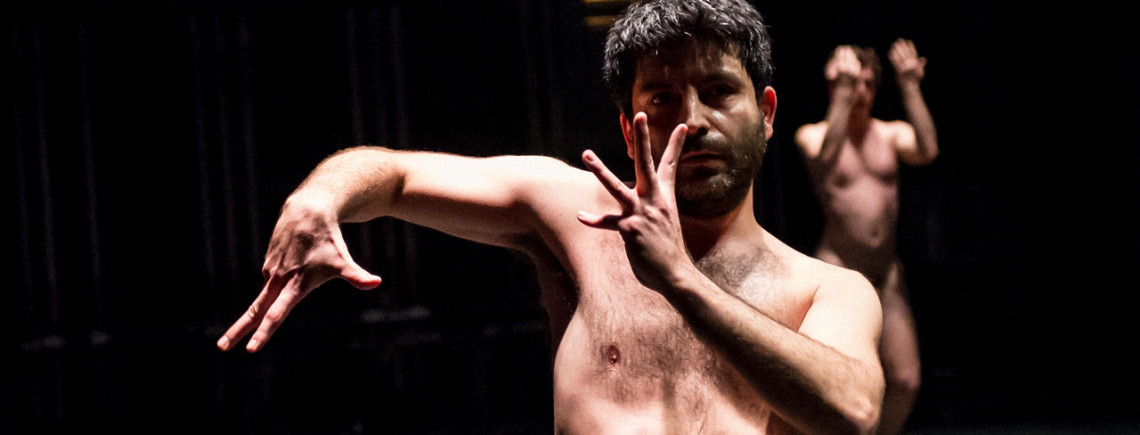
300 words on Realness: Commentary=not thing
300 words on Realness: Commentary=not thing
by Lydia Mokdessi
Published on: January 12, 2014
Juliana F. May’s Commentary=not thing is a rigorous “dance play” that somehow manages to maintain an intensity level of 10 for its duration. Kayvon Pourazar, Ben Asriel, and Talya Epstein gallop in angular pathways, gesticulate manically, spin like dervishes, and emit gasps and high-pitched yelps that later turn to aimless bickering. Their physical language is sharp and assertive while their verbal communications are circular and inane — they perform both sets of tasks with equal conviction. Relationships start to appear but blur away before a narrative can form; Asriel slams his head between Pourazar’s legs from behind, Epstein backs away, pumping her elbows inward like a victory dance before pivoting in place with jutting hips and slicing arms. Everyone is suddenly naked, and Pourazar and Epstein argue cryptically (“this was supposed to be fun. why don’t you tell me what’s going on!”) while Asriel stalks around the furniture, singing about nothing.
The work’s most memorable episode has the three performers joining up to stride in tandem as a small herd. They march open-mouthed, hands positioned as if calling a timeout, and progress from casual contact to smearing sweat across each others arms and backs to full-bodied aggressive groping of chests / butts / genitals. It’s a troubling situation on paper, but somehow personal space and bodily privacy have lost relevance in this environment.
Having exited and re-dressed, the dancers take the stage one at a time for a series of rigid and directional solos. They are austere and assured, their vector-like pathways punctuated by circling wrists on outstretched arms that might be making a grand entrance or casting a spell. There’s a new script, first between Pourazar and Asriel (to me the most interesting and volatile of the short-lived pairings), that again doesn’t quite add up to a conversation (“why are you being so nice to me. I want something personal. In the fucking airport.”) They rip off each other’s shirts or pants (one at a time in this version), brawl, giggle, and slam each other into the metal garage door.
They are never still and they never slow down; Commentary=not thing exists solely in a heightened state. It proposes its own system of logic. It is both emotionally specific and absurd, simultaneously primal and formal.
image: Ian Douglas
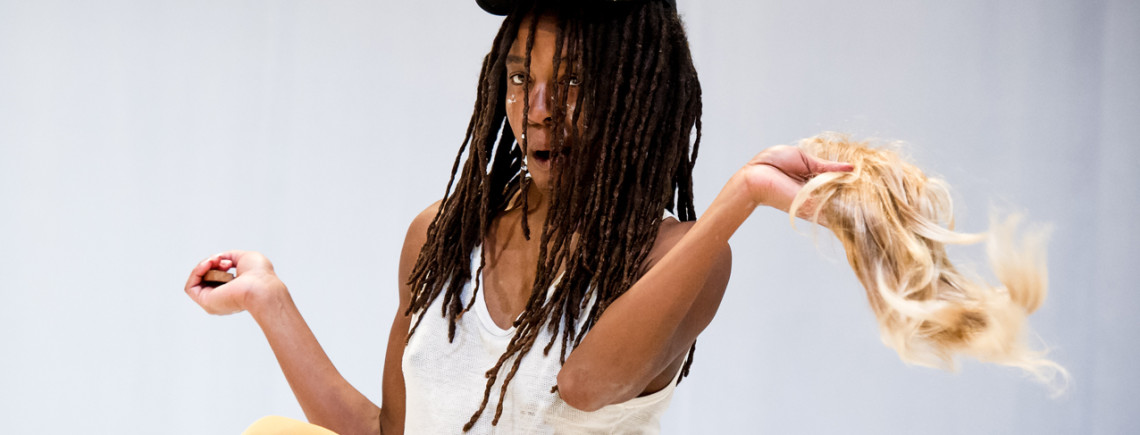
300 Words on Realness: Yellow Towel
300 Words on Realness: Yellow Towel
by Lydia Mokdessi
published on: January 11, 2014
Bodies are messy and weird, and so are identities. What Dana Michel is doing in Yellow Towel is broken, ugly, visceral, unrestrained, and sometimes revolting, but she remains elegant and collected and completely in charge. She enters in black sweats and white creepers, and a collection of white and yellow objects are revealed: a painted trumpet (protruding from her back), q-tips (spilling out of her hat), tissue (unfurling from her chest), grass hula skirt, bananas, blonde ponytail, buttercream frosting, butcher paper, mousy Afro, unplugged microphone, saltines, etc. She hunches and shudders and tiny dances emerge. Fingers escape one at a time from clenched fists. Jaw and tongue thrust forward. Pelvis and knees vibrate.
She cycles rapidly through personas, muttering parts of let there be house (something having to do with the origins of house music in 1980s Chicago), adopting a Caribbean speech pattern, dropping briefly into “yeah bitch, uh huh gggguuuuurrrrlllll,” and episodes of abstracted voguing / locking / twerking. More absurd characters dribble milk down their chins, shove saltines into their mouths by the handful, and take calls on banana-phones before spitting half-chewed banana onto the floor (she talks about toying with ideas of “comedic outsiderness, supposed marginalism and disability”). The elements are numerous, but the work as a whole is unhurried and measured. The impetus for Yellow Towel came from childhood jealousy of classmates with long blonde hair, and the clearest bit of dialogue is on this topic: “My hair is not white hair. This is obvious and stupid. It’s not Chinese hair or Mexican hair or horse hair. I like her hair more better than mine.”
Yellow Towel considers acceptable and unacceptable ways of being in one’s body; how a body consumes, outputs, makes noise, takes up space, and how these actions are policed and self-policed. There is a counterintuitive virtuosity in Michel’s broken / quotidien / basic / indulgent experiments. The audience was rapt, then anxious (someone behind me never stopped foot-wiggling and audibly asked a neighbor for the time), then amused, especially during a rendition of a televised weather report dwelling on the pros and cons of knowing the temperature and the specifics of the polar vortex (something about pressure systems and da souf n da norf ting). After her exit, we looked at each other, shook our heads, and chuckled. But when she returned to bow sheepishly with a hand still full of marshmallow fluff, she was met with an eruption of support.
image: Ian Douglas
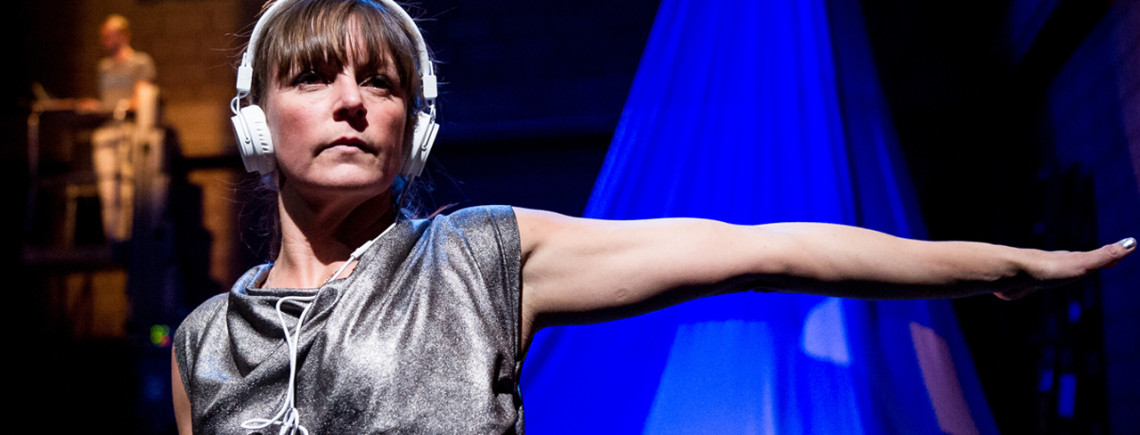
300 words on Realness: …Too Freedom…
300 words on Realness: …Too Freedom…
by Lydia Mokdessi
Published on: January 11, 2014
Adrienne Truscott’s …Too Freedom… is not the same dance in American Realness 2014 as it was in December 2012 at The Kitchen. Neal Medlyn is still funny and unsettling in his spastic episode in the stage lift and elegant in his minimal rendering of Truscott’s simple core phrase. Gillian Walsh and Laura Sheedy are still composed and a little menacing while leading latecomers to their seats and civilly dismantling a roast chicken. Adrienne is dogged, bordering on manic in her companionless rehearsing. Mickey Mahar is completely engrossing, floppy and elastic and totally comfortable with his weirdness. This time, though, the work on the whole feels a little more offhand and a little less earnest, which is an unexpected and welcome shift.
Perhaps everyone in the audience had seen the piece last season — the response felt more in-on-the-joke, less contemplative or admiring. People openly laughed at Neal’s screaming fit (I still found it horrifying, but I can’t stand watching people in even fake-pain), when Adrienne wiggled too close to the front row, and during her concluding Spanish conversation with the jornaleros (day laborers). At The Kitchen, there was a sense of gratitude for them — maybe they got their own bow or were held apart in some other way. Here they are just part of the cast, which fits well. The demands of the performers are undeniably linked to those of the jornaleros (job stability, physical concerns, low wages), but the question of utility hangs in the air. Presumably, in their day to day lives, the men are reliably compensated for the production of material structures; the value of their labor is explicit. Of course, the value of the performers’ labor depends on who you’re asking.
The more complex question is about spectatorship (“can you not stare at me for a long time?” Gillian asks). The idea that being watched while working is an inherently vulnerable position is especially potent when the worker’s job is to be watched. …Too Freedom… is function over form; dancing is a job like any other job.
image: Ian Douglas
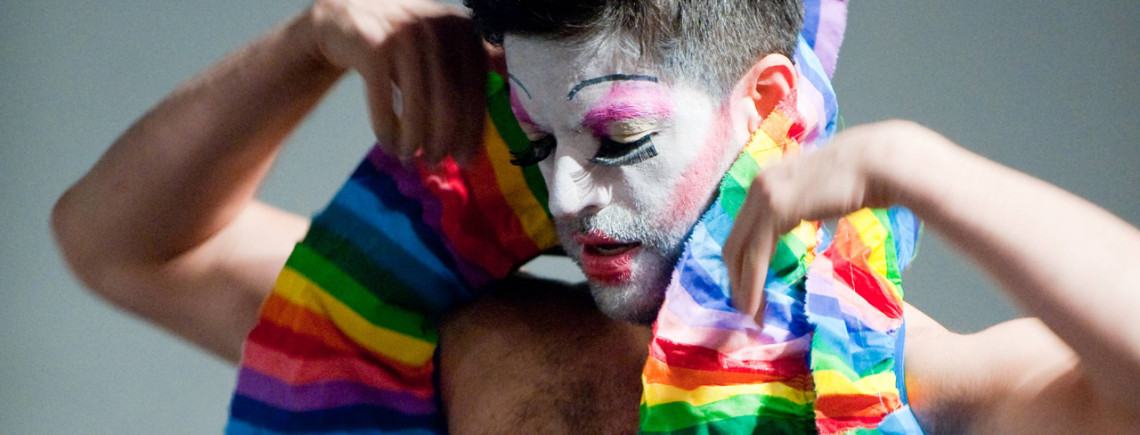
How to Do Things With REALNESS
How to Do Things With REALNESS
by Ryan Tracy
Published on: January 9, 2014
To speak, to say something, is no simple task. We all have to learn to speak. Speech implies teach, or pedagogy. We teach speech by example, or, by offering our own speech as a model to be copied, echoed, repeated. Put another way: The process of speech is a process of appropriation. And yet we also rely on speech to represent ourselves as authentic individuals. The imperative to know oneself is accompanied by an incitement to speak oneself, to express one’s true self in speech and, by doing so, to become sociable; able to mix in a world of self-representing, speaking subjects. But the ability to speak is not distributed uniformly. Speech is not immune to vectors of power. In fact, speech, speaking, is a demonstration of power, or evidence of power’s operation as speech. Who can speak has everything to do with who can be heard. Gayatri Spivak will tell us that power as speech determines not only who may speak but also who may be spoken for. Sometimes we have to fight to speak; to be heard. Speech, we might say, is the oral/aural fight of feminism. But speech’s entanglement with powers of domination, thankfully, is not totalizing. We figure speech. We play with speech. We plie; we pun. No wonder our speech gets us into trouble. Sometimes we invite that trouble. We speak a dare. Sometimes our speech “misfires” and we are challenged with the paradoxical task of correcting our misspeech with more speech. Queer theory and poststructuralism have taught us that speech constitutes at the same time it disturbs. The “I” of troublesome identity is, it is said, a “speaking I,” one that can never lodge itself into a stable position since every claim of identity displaces prior claims, or, as Judith Butler coming down from the mountain has revealed to us—“The copula is empty.” A speaking being, rather, becomes a doing that undoes. Speech haunts our attempts to represent a fixed world in speech. Psychoanalysis will tie the ability to speak as a speaking subject to the acquisition of desire. A world that speaks through speaking subjects is thus a desirous world, a symbolic world, one at constant odds with childish need and maternal narcissism. Julia Kristeva will describe this as a tension between the echolalia of childhood language games and that of a symbolic order of speaking (masculine) subjects. But the subjects we teach to speak—children, characters—return our speech to us appropriated, altered, other, and out of bounds. Speech, then, we might say, abounds; and bounds. Speech leaps between subjects. Speech ties, twists and turns. Derrida once figured the repetition in speech as a pirouette. Thus, speech might only be dance after all; not the dance of presence, but the dance between absence and presence; the ever passing between them.
To speak of Ben Pryor’s American Realness festival, returning to the Abrons Arts Center for a fifth iteration, is to speak of a curatorial endeavor that speaks in multiple ways. The festival speaks to performance; specifically, to contemporary performance. American Realness speaks insofar as it states, or, makes a statement, and in doing so, makes particular currents in performance legible, learnable, in fact, speakable; i.e. pushing boundaries, crossing disciplines, thinking sex, making performance in “an American context”. Looking back, speech—in all its complexity, calculation, fabulousness, magic, danger and ecstasy—seems to be a current that runs through each statement of this festival. Put another way, speech might be the currency of American Realness.
Of the eight shows presented in 2010, a few speak immediately to this. Ann Liv Young, Jeremy Wade, Miguel Gutierrez, Jack Ferver, Trajal Harrell, Layard Thompson. All of these artists speak in their work, and speak uniquely to the work of dance and performance making. Ann Liv Young regularly speaks out of turn; that is, when she speaks as Snow White, or Sleeping Beauty, or Sherry…or Martha Washington…her speech betrays the expectation that a character will fully encase the performer in a world of alterity. The “real” of speech, if we can say there is such a thing, is never far away or predictably locatable, and its threat of emergence, no doubt, is what drives Young’s work while fascinating, frustrating, and inciting her audience. Jeremy Wade and Layard Thompson, in different tracks, speak to the ineffable in speech, or to the places where language as such breaks down and the speech we are left with is ecstatic, dumb, visceral, and deeply reliant on affective hermeneutics. Miguel Gutierrez speaks—a lot—of the political, of the poetic, of the erotic and the emotional. Jack Ferver speaks the “I,” the “me,” the “my,” and the “mine,” maybe more than anyone. And Trajal Harrell speaks to the politics of representation, the trouble with authenticity and the need to ask ourselves questions. Then work from there.
In 2011, Pryor worked with Ishmael Houston-Jones, Dennis Cooper and Chris Cochrane to restage THEM, a work originally made and performed at the height of the AIDS crisis when being heard often came down to one’s willingness to act up. 2012 brought Big Art Group’s Broke House and an in-progress showing of Keith Hennessy’s Turbulence, both speaking to the perils and fantasies of an economy in crisis. American Pussy Faggot Realness conjugated two curatorial practices (Ben Pryor + Earl Dax) around an affinity for queer speech. Todd Shalom and Niegel Smith gave us Elastic City’s Salve, where to participate was to speak, more or less, poetically. And I joined photographer Michael Hart for UNREAL, an exhibition of performance portraiture, or a performance of portraiture, inscribed with an acrostic I wrote based on Jacques’ monologue from As You Like It. If all the world, after all, is a stage, then it is a stage that speaks not only in the speaking of its players, but in “the rest” of their silence as well.
Perhaps as important as the identitarian question Who speaks? might be the ontological question What speaks? It is easier to say who speaks. “He” speaks. “She” speaks. Often “it” speaks. At the very least, someone speaks. Institutions, no doubt, speak. But speech speaks not through, but as bodies; between bodies. Can we say bodies speak? Or, speaking bodies speak? Does speech, in fact, require something like a person? Or, can we say that speech, above all, requires an event; an embodied event; a speech act? Foregrounding, as it does, the question of the body—its abilities, its limits, its problems, its feelings, its surfaces, its fluids—American Realness begs the question: What body speaks? Or. What is the event in which the spoken body is speaking? Looking at some of the lineup for this year’s festival, we might draw some answers. In Miguel Gutierrez’s myendlesslove, the lovelorn body speaks. With Sherry’s Art Fair, the therapeutic body speaks, as does the makeshift capitalist. In Neal Medlyn’s King, the iconic body speaks. In Adrienne Truscott’s …To Freedom…, the laboring body speaks. In Dana Michel’s Yellow Towel, the remembered body speaks; the black body speaks. In Prodigal Heroes, with Lucy Sexton, Ann Iobst, and Scott Heron, the legendary body speaks. And in Rebecca Patek’s ineter(a)nal f/ear, the fucked body speaks.
The trouble with speaking bodies is that they regularly say what we don’t want to hear. Speaking bodies possess the capacity to hurt and enrage just as easily as they have to capacity to bring pleasure and a sense of order to things. Perhaps this explains Americans’ particularly thorny relationship to speech, if “relationship” is even the word to use. Perhaps, independence is a better word. To rephrase, then: Americans have a particularly thorny independence to speech. America (already an appropriated name for “freedom”) as a project of the democratic turn of modernity, was inaugurated with a declaration, a speech act, of independence. This declaration, and its subsequent constitution, ensures a freedom of speech. But does this mean, simply, that citizen-subjects are free to speak as they please? Speaking freely? Or is this freedom of speech an acknowledgement of speech’s independent status from ever being fully regulated? So that speech, if it likes, can take its leave of us, and we are drawn to the sisyphean task of reining it back? Or might the freedom of speech mean that the freedom we are guaranteed possesses a quality found in speech? That is, the freedom of body, or, the freedom to act as citizens is in some crucial way speech-like? If we figure Americans’ independence to speech as a compulsive ambivalence toward speech’s ability to delimit freedom, then we can see more clearly the ways in which the freedom of speech vexes the project of a secure American democracy founded upon the speech act of collective self-representation (i.e. “We, the people…”). Americans do acknowledge that sometimes action is speech, as in the action of burning an American flag. We have also acknowledged, for a time at least, that speech is action, as in “Don’t Ask Don’t Tell”s proposition that to say “I am a homosexual” is in effect to commit a homosexual act. And I can’t think of anything more American than the Supreme Court’s decision in Citizen’s United, a decision made the same year that the American Realness festival was founded, that money, at the end of the day, is speech. If money is speech—and, as currency, it very well might be—the de facto cultural agreement in America that the government should not fund the arts speaks volumes. The artists presented at American Realness are all working to speak (as artists) against a political context that reserves speech (as money) for the utilitarian, the pragmatic, the reactionary, what we might just generalize as, the military. What does it mean to speak in this context? It will be telling that all the artists presented at this year’s festival are being billed as “international artists” whose acts, often, speak elsewhere; places outside American borders; places where speech—as money—invites and sustains American artists to speak there. It is here that American Realness has always been, wonderfully, a bit unAmerican.
Likening democracy to literature as a space in which everything must be said, Derrida’s saying of everything articulates the conceptual structure that ensures democracy’s self-destabilization, as well as its penetrability to otherness, and its inability to be contained within the parameters of a given border. I would like to argue that the stage of contemporary performance shares with literature and democracy this quality of a saying of everything, this utter(able) penetrability, or interpenetration of speech and event. As an event, American Realness extends the field of speech, expanding both what we call performance and what performance says, while also rewriting the context in which these performances are made and presented. Five years along, “Realness” is a personal, political, aesthetic and, to no small degree, financial investment in an ideal, and, like all investments, there is no guarantee of return, which is what makes currency, democracy and this festival—as the saying goes—a risky business.
image: Ian Douglas

Hashtagging Dance
Hashtagging Dance
by Effie Bowen
Published on Jan 8, 2014
American Realness is a festival of contemporary dance, originated as an aesthetic counterpoint to the January performance marathon known as APAP. Dedicated to showing dance and performance work frequently deemed “marginal,” there has always been an edgy air to the works shown in American Realness, especially compared to the decidedly more conservative shows as a part of APAP.
When I was asked to contribute something for the zine this year, I decided to focus on POP as a theme and container that holds much of the work at American Realness. (I will refer to POP in all caps and treat it as an all-encompassing moniker: Pop culture, pop music, the VMA’s, PerezHilton.com©, or anything currently #streaming or #trending on #socialmedia or #television are all included in what makes pop POP.) Knowing most of the presenting artists and their work in prior contexts doesn’t inspire me to launch into an essay qualifying their practice as anything so commercialized or easily digested as POP is formatted to be. After all, Wade Robson isn’t showing at American Realness, Ishmael Houston-Jones is. The work made for and presented at American Realness will never enter the sphere of POP completely for numerous reasons but that doesn’t keep artists from referencing, appropriating, distorting, or ignoring the influence and impact of POP.
POP is designed for quick consumption, digestion, and excretion, and there happens to be so much of it, that what was “contemporary” one second is forgotten the next. Trends don’t enter or depart at such an expedited rate in dance and the connection between POP and dance is frequently, if not exclusively, a discussion around the involvement of popular music in our genre. So what do I think about when I think about POP? Music videos, television shows, and album releases come to mind but for better or worse downtown dance hasn’t penetrated the viral video market like “tutting” or the Harlem Shake have. Even participants on “So You Think You Can Dance” never reached the popularity ranks of Miley Cyrus’ “Wrecking Ball.” Our marginalized form, perhaps, is too multidimensional to be flattened into a meme so what do we mean to talk about when we talk about POP in dance?
Pop culture and dance, though on different planets in terms of money and access, aren’t such distant relatives, and at the start of 2014 we could reminisce at this past years cultural phenomena inextricably tied up in dance: Rick Owen’s controversial step runway show, Miley Cyrus twerking at the VMAs, in addition to other cultural currency “starring dance.” Films like Silver Linings Playbook, Frances Ha, and television shows like “Bun Heads” and “Dance Moms” let dance enter their field, capitalizing on a form grossly less reliant on product, viewership and sales. Pop music has used dance for much longer and superstars like Michael Jackson and Madonna were just as famous for their dance moves as the sounds they produced. The growth of pop alongside the prominence of television was not happenstance, but a vital collaboration. Pop music and pop culture were and are visual fields, another means by which dance and POP and performance relate and reflect back and forth between one another with such ease.
POP’s prolific dominance over our lives is a marketplace system, it creates commodities as well as desire for said commodities, but it also produces ephemeral non-objects like nostalgia. POP can create moods and feelings and memories. It is a widespread, far reaching placeholder, frequently easier to refer to than our own vague recollections of “personal” events. Given the opportunity, POP can usher us back in time and allow our minds to weave together a mash up version of history, part personal, and part product. This POP effect is particularly salient, especially when considering POP with dance because it is pseudo-choreographic. The manipulation of space and time that occurs in memory is expanded in POP memory because it was so prominent and publicized the first time around. Recalling listening to Britney Spears’ first album evokes nostalgia, sure, but it feels fraught with meaning because of the weight of its original sensationalism. So many POP signifiers are intertwined in the actual album that to recall that object is also to recall the fashions, musical effects, advertising and aesthetics of 1999. POP nostalgia is a publicly private remembering. The closest dance comes to POP is in this nostalgic remembering. The ghosts of dance’s ephemerality are equally haunting in their ability to be quickly conjured and resurrect feelings and memories previously had.
American Realness, in its fifth year, presents works that most highly relate to POP ephemera. There are works that relate to POP either through their inclusion of certain soundtracks or objects or pieces that disrupt categorization all together. Given its dominance over our lives at the moment, I shape the following by titling paragraphs with adjectives used to qualify pop music according to Wikipedia, because it seems a relevant means by which to place POP and dances occurring within and outside of American Realness, literally, side by side.
ECLECTIC
Though it is set in a dance studio in a small town and involves a competition, Tina Satter’s House of Dance doesn’t mirror popular dance programs like “So You Think You Can Dance” or the more comically vicious “Dance Moms.” It’s nostalgic yet somewhat current, set in a static space in a liminal time: Jess Barbagallo’s character Lee uses their cell phone but doesn’t, for example, talk about Facebook©. House of Dance extends our imagination to a time before the viral embarrassments of celebrity and common folk rapidly distributed on YouTube© and our television screens. House of Dance layers outdated “pop” paraphernalia as a reminder of changing times.
House of Dance is set in the dark basement of Abrons Art Center and queers the tale of a young dancer trying to “make it.” None of the characters are extraordinary dancers, but they aren’t hyperbole of themselves, the way they would be if on a TV show. House of Dance is POP nostalgic because it is a familiar story yet too eclectic to be labeled efficiently. The characters, settings, and props are a little “off,” a credit to the astute performance of awkwardness and melancholy by the small ensemble. Lines are delivered with sporadic slow pauses and there are sequins, headscarves, and a song by Melissa Etheridge, all references for a decidedly non-contemporary, yet POP moment.
HARMONY
Jillian Peña’s new work, Polly Pocket, is “an epic dance drama.” We are spectators to an inner world of actions and relationships but not privy to ever become involved. Cast as passive observers, we are destined to watch the drama unfolding before our eyes without explicitly participating. Peña’s ballet-referential choreography and trending toy title brings us back to earlier times whether we have personal relationships with ballet and Polly Pocket™s or not. This sourcing from the past creates a POP nostalgia that is curated by Peña rather than copying POP currency that was once on trend. Polly Pocket is named after the toy that reached their hay-day in the nineties, branded exclusively to girls. Polly Pocket™s were essentially portable dollhouses with the dolls, character backgrounds, accessories, and furniture all included in the plastic seashell shaped home. Opening the appropriately pocket-sized toy was to open oneself to a complete world, one was both the voyeur and director of the life and times of those miniature bodies. In Polly Pocket, the director’s seat is taken and we succumb to watching a world of live relationships unfold before our eyes instead of controlling the story we want our “dolls” to perform. Peña evokes history, trend, and sensation not by replicating the past but restructuring and complicating our relationship to it.
BORROWING
Neal Medlyn’s work goes straight to the source, puncturing the artery of POP. The musician/performer/rapper’s work disseminates our culture of pop idolatry not by merely questioning celebrity culture or through performative abstraction but by creating pieces that allow him to act like the subject in question. From Miley Cyrus to Lionel Richie, Medlyn doesn’t attempt to replicate these celebrity bodies, but does access their tools and tropes, borrowing from stardom. Medlyn’s The Pop Star Series, started in 2006, is a collection of shows each dealing with the life and times of pop sensations and culminates with King, an ode to Michael Jackson. According to Medlyn, “King is about epic attempts.” The same could be said for the entirety of The Pop Star Series as it borrows from celebrity without trying to replicate. It definitely does not offer a tongue in cheek or ironic bashing of popular music or its darlings. It doesn’t place POP icons on a pedestal either, but reveals constructs of celebrity, culture, and pop currency without preaching to the viewers.
MULTIPLE GENRES
Similar to Medlyn’s The Pop Star Series, Ann Liv Young is the object of her own POP sensation. With the birth of Sherry, a sassy Southern blonde who loves confrontation, Young created her own POP currency. Sherry offers therapy—aptly titled “Sherapy” —has a food truck, and sells her wares including but not limited to leftover paraphernalia or props from shows, DVDs of work, and traditional “merch.” The Sherry brand is precise and irreverent and appropriates the trope of celebrity but hopes we still engage with it. Young’s POP currency comments on star worshipping, she has a bag of glittered poop for sale on her website, but I have no doubt about her ability to put money where her mouth is. Sherry’s merch reveals the value systems of POP commerce precisely because she isn’t a traditional superstar. She places herself in the center of contemporary sensations: art fairs, foodie culture and allows her audience to contemplate the value of fancy coffees or expensive art objects, all the while hoping, at the end of the day, we partake.
CATCHY HOOKS
13 Love Songs: dot dot dot by Ishmael Houston-Jones and Emily Wexler is a collaboration between two artists not at all resistant to shy away from the grand or dramatic but their works veer more avant-garde than pop. Their individual pieces are frequently concerned with identity, longing, and belonging and in their new work, they seek to explore their belief in the corrosive nature of the pop song. Houston-Jones and Wexler are interested in love and as suggested by their title, the 13 (maybe 14) pop songs that accompany their piece will only deepen the exploration of that sometimes trite, sometimes significant emotion. Pop songs are well-versed in the expression of love and there is a pop song for every facet of that emotion: falling in love, betrayal, desire, heartbreak, longing, joy. More than any other musical genre, POP capitalizes on love, but Houston-Jones and Wexler aim to take it back. Armed with weapons, personal texts, and their ability to be both vulnerable and virulent, POP won’t have much to stand on once Houston-Jones and Wexler confront it.
WHAT WE TALK ABOUT WHEN WE TALK ABOUT POP
POP has and will continue to engage and exploit the endeavors of less publicized and less funded forms of expression but it also provides apt cultural context to creative works and especially body based forms. For as much as POP appropriates from its unnamed minions, many artists, choreographers, and performers are beginning to reflect rather than reject POP devices like drama, celebrity, and voyeurism. Instead of vehemently resisting the daily impact of POP upon our lives, dance artists are collaborating with the cultural currency inherent in POP. POP is a marketplace, and it depends upon our willingness to purchase what it produces, but artists who appropriate from POP instead of the other way around craft a space for critical thinking around a form that has been historically approved of automatically without space for theory or question.
The predictable pattern of POP is embarrassingly unremarkable. Headlines about celebrity pregnancy, weight loss, relationships, cheating, and fashion choices become as mindless as the chorus of a top POP song. “Take it, take it, baby, baby, take it, take it, love me, love me.” Artists “remixing” POP use POP products, a song, a line from a TV show, or an Internet meme to hit against other non-POP elements. In this form, POP remains an overarching reference, inside and outside the theater, gallery, or other presenting space. The mundane-ness of POP is displayed or questioned or mimed as if to make us question our constant spectatorship of such a commercialized and predictable subject.
Vastly more interesting are dance artists who appropriate from POP without parameters, making pieces that confront and question our propensity for POP obsession and worship. Pieces like Sophia Cleary’s God Bless the Group utilized a mass of youthful, vibratory bodies seeming to physically digest the excesses of the Internet and blog culture. When I saw this work at 109 Gallery earlier this year, the arranged formation of bodies was static in space but energetically pulsing to the equally repetitive score by AIDS 3D. Hyperactive and animated, yet not “going anywhere” they seemingly became a Tumblr© feed, their bodies repeating actions over and over again like gifs. Spookily similar to the quick entry into the infinite world of consumable images of fashion, food, meme, celebrity, and art on the Internet, the performers didn’t have to mimic Tyra Banks or sing a song by Eminem to tag themselves as a living archive of POP, their bodies held it all. I watched them perform and was transported into a new world of simultaneous presence and distance, glazed over by my access to excess.
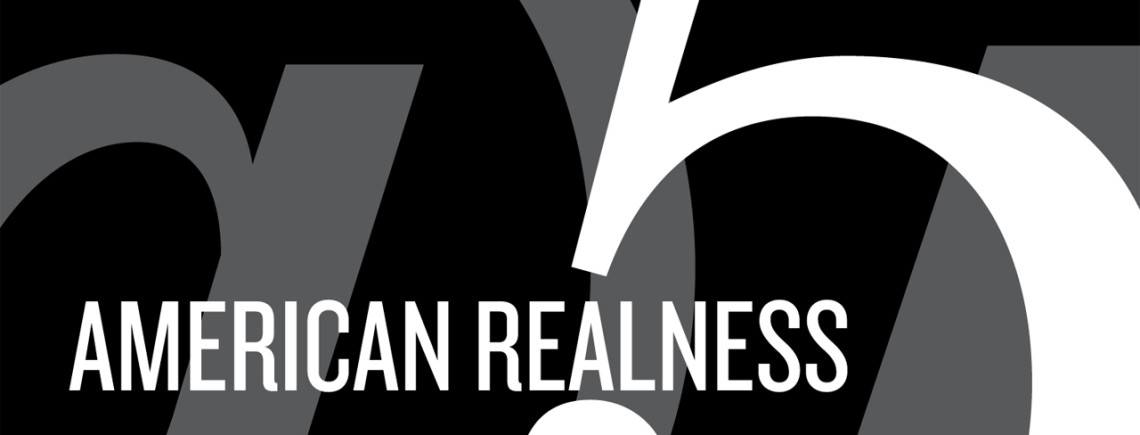
Editor’s Note
American Realness turns 5!
Big F*cking Deal.
by Buck Wanner
Five years somehow seems like an appropriate moment for reflection. When American Realness appeared for the first time in January 2010, it was an immediate breath of fresh air to the downtown dance scene. Exciting, provocative, and expressly American, it gave us remounts of some of our favorite pieces of the past year—a rare occurrence in this community—as well as a few things that hadn’t made it to New York, within the span of a few short days. And it arrived just after the New Year. Most of us had had a few days break for various holidays, so were all refreshed and whatnot, and we got to start off the year with a concentrated dosage of awesome dances that we either loved and wanted to see again, or missed and excitedly got to catch this second time around. It was a hit, and it gave us a hit of energy during a time when we generally laid back, attended our rehearsals, or went and saw any of the dozens of theater shows we finally had time to see since there weren’t any dance shows happening.
Since then it’s recurred, expanded, added new directions. And become a staple. When the festival first landed, it came as a surprise. American Realness is not going to surprise us anymore, at least not in that sense, because we expect it now.
And about time.
In considering how Reading (yet another recent development of this festival) should relate to the festival this year, one phrase from the press release stuck with me: “once again”. Almost every mention of the festival over the past years included some nod to it being “challenging”, “upstart”, even “game-changing”. Well, consider the game changed. At five years running, it would seem strange to suggest that the festival is still an upstart. American Realness is now established, its format repeatable, its content categorizable. Where the first years featured manifestos, now the announcements get straight into the content of the festival itself.
But doesn’t that just mean that we have come to recognize what the festival initially sought to draw our attention to? The festival argued for the recognition of a particular aesthetic, one that we now notice out in the world partially because it has been highlighted year after year in American Realness. Now the festival is even pushing the recognition of that aesthetic beyond the borders of its initial American particularity. Forget fighting for a place at the table—let’s go find some more tables to sit at.
The festival has been highly successful at pointing out what was sorely missing from the landscape of APAP and the January festival season. But now that we’ve noticed, let’s take a closer look at what this thing is, what the work it presents is giving us, what the artists who make up these 11 days in January do—not “do differently”, but just do, on their own terms. Again, somehow five years seems to allow for a moment of reflection. This also reiterates the concept of Reading, which is to reflect on the festival, which itself already reflects on the performance landscape. In this vein, I invited contributors to focus on what the festival is, in itself, both in the broader landscape and on its own, within its own history. For some this will manifest in broad reflections on aesthetic or political themes, for others it stays close to individual artists and issues in their work. What I hope this year’s iteration of Reading can do is give us ways to think about what the artists in the festival do individually as well as what they say in the context of one another. I’m looking forward to reading thoughts and writings from Effie Bowen, Ryan Tracy, Samara Davis, Jeremy Barker, Marissa Perel, Lydia Mokdessi, Lauren Bakst, and Keith Hennessy. Their writings will appear here over the course of the next several days, so keep checking back in for provocations, investigations, and perspectives concerning the shows, works and events you’ll be attending through January 19th. Five years and running—let’s see what all these people have to say.

Shade comes from reading
Welcome to READING.
Reading started as a zine for American Realness 2013 edited by Moriah Evans, Buck Wanner and Ben Pryor. It was supposed to be a catalogue but we didn’t have enough money to make it sexy enough to call it a catalogue. So we made it a zine cause this shit has always been DIY, so what are we trying to pretend for?!
